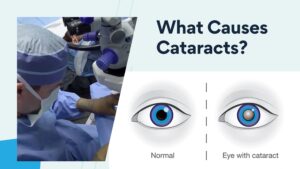What Causes Cataracts?
What are the causes of cataracts?
What is a cataract?
A cataract is a clouding of the eye’s natural lens, which lies behind the iris and pupil. The lens works much like the lens of a camera, focusing light onto the retina at the back of the eye so that we can see clearly.
With age, cataracts usually occur when the proteins in the lens begin to break down and clump together. This causes the lens to become less transparent and makes it more difficult to see.
In most cases, cataracts develop slowly and don’t cause pain or other symptoms. However, as they progress, they may cause vision problems such as blurry or fuzzy vision, trouble seeing at night, or a need for brighter light when reading or doing other close work.
In some cases, cataracts can lead to more serious problems such as double vision, seeing “halos” around lights, and a decrease in color perception.
Cataracts are very common, especially among older adults. In fact, according to the American Academy of Ophthalmology (AAO), by age 80, more than half of all Americans either have a cataract or have had cataract surgery.
While cataracts are often associated with aging, they can also occur in young people. Cataracts may be caused by injury to the eye, certain diseases such as diabetes, or prolonged exposure to ultraviolet (UV) light from the sun or tanning beds.
Causes of Cataracts
– Age: As we age, our lenses naturally begin to harden and thicken, making it more difficult for light to pass through. This can eventually lead to cataracts.
– UV Exposure: Prolonged exposure to ultraviolet (UV) radiation from the sun can damage the proteins in your eyes, leading to cataracts.
– Diabetes: People with diabetes are at a higher risk for developing cataracts. This is because high blood sugar levels can damage proteins in the eye lens, causing cataracts to form.
– Smoking: Smoking is another major risk factor for cataracts. The chemicals in cigarettes can damage proteins in the eye lens, leading to cataracts.
Cataract Prevention
If you are at risk for cataracts, there are some things you can do to slow down the progression, including:
– Wearing sunglasses: Sunglasses can help protect your eyes from UV radiation and reduce your risk of cataracts.
– Eating a healthy diet: Eating a diet rich in antioxidants can help protect your eyes from damage and reduce your risk of cataracts.
– quitting smoking: If you smoke, quitting is one of the best things you can do for your overall health—including your eye health. Quitting smoking can help reduce your risk of cataracts.
Cataract Treatment San Antonio
Cataracts are usually treated with surgery, which involves removing the cloudy lens and replacing it with an artificial lens. Cataract surgery is usually safe and effective, and it can help improve your vision. If you have cataracts, the only way to treat them is with surgery. During cataract surgery, the cloudy lens is removed and replaced with an artificial lens. Cataract surgery is usually very successful and can help improve your vision.
Can I Get Cataracts in Both Eyes?
Cataracts in both eyes are possible. If cataracts are present in both eyes, you may experience symptoms in one eye before the other. However, cataract surgery can usually improve vision in both eyes.
What are the types of cataracts?
Cataracts can be classified according to their location in the eye, how they develop, or what causes them.
– Congenital cataracts: These cataracts are present at birth or develop in early childhood. They may be caused by a genetic disorder, infection during pregnancy, or injury to the eye.
– Subcapsular cataracts: These cataracts form on the back surface of the lens. They are more common in people with diabetes or who take certain medications such as steroids.
– Nuclear cataracts: These cataracts form in the nucleus, or center, of the lens. They are the most common type of cataract and are typically associated with aging.
If you are experiencing symptoms of cataracts, give our office a call at (210) 585-2020 to schedule a consultation.
Be sure to talk to one of our doctors about not only the benefits of vision correction, but also any risks of vision correction that may pertain to your individual needs and circumstances.


